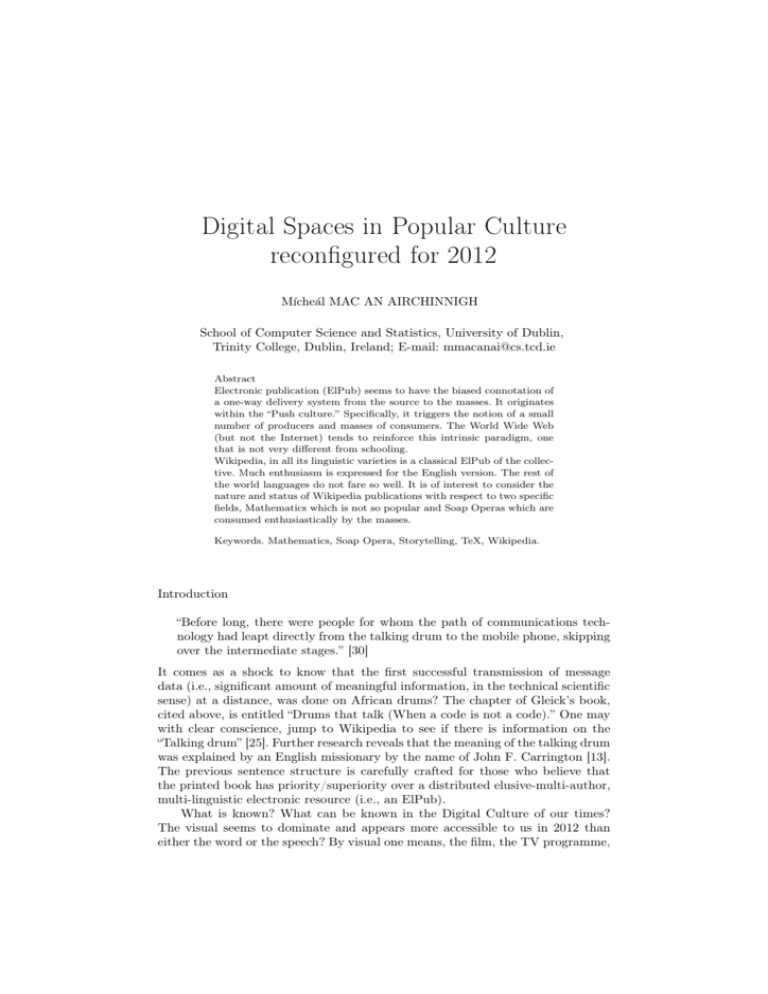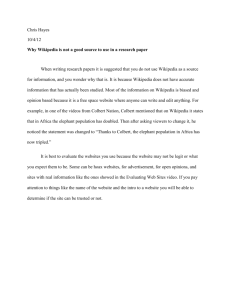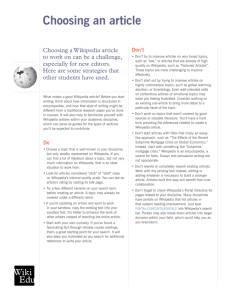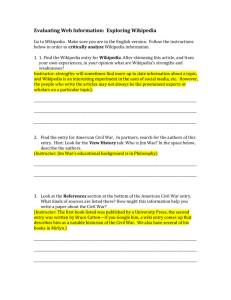Digital Spaces in Popular Culture reconfigured for 2012
advertisement

Digital Spaces in Popular Culture reconfigured for 2012 Mı́cheál MAC AN AIRCHINNIGH School of Computer Science and Statistics, University of Dublin, Trinity College, Dublin, Ireland; E-mail: mmacanai@cs.tcd.ie Abstract Electronic publication (ElPub) seems to have the biased connotation of a one-way delivery system from the source to the masses. It originates within the “Push culture.” Specifically, it triggers the notion of a small number of producers and masses of consumers. The World Wide Web (but not the Internet) tends to reinforce this intrinsic paradigm, one that is not very different from schooling. Wikipedia, in all its linguistic varieties is a classical ElPub of the collective. Much enthusiasm is expressed for the English version. The rest of the world languages do not fare so well. It is of interest to consider the nature and status of Wikipedia publications with respect to two specific fields, Mathematics which is not so popular and Soap Operas which are consumed enthusiastically by the masses. Keywords. Mathematics, Soap Opera, Storytelling, TeX, Wikipedia. Introduction “Before long, there were people for whom the path of communications technology had leapt directly from the talking drum to the mobile phone, skipping over the intermediate stages.” [30] It comes as a shock to know that the first successful transmission of message data (i.e., significant amount of meaningful information, in the technical scientific sense) at a distance, was done on African drums? The chapter of Gleick’s book, cited above, is entitled “Drums that talk (When a code is not a code).” One may with clear conscience, jump to Wikipedia to see if there is information on the “Talking drum” [25]. Further research reveals that the meaning of the talking drum was explained by an English missionary by the name of John F. Carrington [13]. The previous sentence structure is carefully crafted for those who believe that the printed book has priority/superiority over a distributed elusive-multi-author, multi-linguistic electronic resource (i.e., an ElPub). What is known? What can be known in the Digital Culture of our times? The visual seems to dominate and appears more accessible to us in 2012 than either the word or the speech? By visual one means, the film, the TV programme, the picture, the poster, in other words that thing towards which the eyes are immediately drawn. In certain cultures at particular times, some kinds of images have been strictly forbidden [11], [36], [12], even unto our own times. Now is a good time to introduce our two letter naming convention for different language versions of Wikipedia. For the big English Wikipedia one might obviously write WP. But the Portuguese version cited second above would have the same abbreviation. Hence, due to the ambiguity of the two-letter code, one further suggests the use of the international linguistic forms “en” and “pt” to distinguish these two distinct language versions, and propose the forms enWP and ptWP. One might have arrived at the same result by noticing the construction of the respective main Wikipedia page URLs. The third reference above, in Cyrillic, is to the Bulgarian Wikipedia. Hence one proposes the use of bgУП, preserving the current English prefix, but respecting the Cyrillic abbreviation. Later on one will have a similar naming problem to resolve for actors and the roles that they play in particular Soap Operas. Again, the natural language versions need to be multi-faceted, if only to be harmonized with respect to the usual sorts of accounts given in the various linguistic versions of Wikipedia. Similarly, is one not also aware of the apparent dominance of the “electronic publication” of music within the general realm of sound? Might there not be a good reason for an aural uprising against the “digital sound?” [7], [23]. Apparently, not! According to John Naughton’s account, “Karlheinz Brandenberg . . . [working in the field of psychoacoustics. . . discovered the existence of] ‘audio illusions’ ” [34]. On a speculative note one recalls the significance of the digital musical sounds for alien–human communication (story telling?) in “Close encounters of the Third Kind” [6]. From sound we are brought back to sight, to recall a similar kind of encoding for the image: the JPEG algorithm[14] and the subsequent development of JPEG 2000[15]. There are, of course, many other encodings for images. Wikipedia has a very high profile in the English-speaking world. Access to a particular page in enWP ([en] may be omitted on the understanding that, by default, one is accessing the English version of WP) on a specific date may be registered in the standard ISO format [yyyymmdd]. For example, the ElPub conference title for 2012 is “Digital shapes of future publishing.” Let us now turn to the English language Wikipedia (formally denoted by enWP[20120109]) to see what kinds of interpretations are currently given to this interesting idea of the “digital shape.” Naturally, one will want to compare search results with the more primitive “shape.” One is surprised, perhaps, to find that there is no Wikipedia entry for such a phrase! One is invited to create such a page. With this challenge in mind, we will look briefly at some possible threads. En passant, we note that there are Wikipedia competitors of all sorts in 2012. For example, a search on the phrase “Criticism of Wikipedia” will bring up many interesting WebSites, of which Knol [2] is a special one. It is also noteworthy that Google is terminating Knol on May 1, 2012, with explicit rationale [3]. The phrase “digital shapes” conjures up, in the first instance perhaps, geometrical digital shapes? In other words, in this context the digital shape in not amorphous. It has a certain familiarity. If we imagine, a triangle, a square, a rectangle, a circle, we conjure up in our minds the corresponding familiar shape. To speak of the Pentagon, with deliberate capitalization, recalls the shape of that building of the same name in Arlington County, Virginia, near Washington D.C., and separated from same by the Potomac river. Such specifically geometrical shapes lie at the very foundation of all civilizations and the artefacts that arose therefrom. We have spoken of enclosed geometrical shapes. There are, of course, many recognizable open shapes, initially considered 1-dimensional, such as lines and curves. The curve may be considered to come from an outline, that is to say, the shape extracted from some concrete structure such as a classical arched bridge, or even the observed trajectory of a missile fired from a catapult. In the latter context, we may speak of the shape of the parabola. This preamble on geometric shapes is also an excuse to introduce the kind of electronic publication that has to a certain extent revolutionised the way in which we do Mathematics, not only in presentation and practical work, but also in the manner of examination. In particular, one notes below that the students electronically publish their solutions to the exam questions. The public who has access to these solutions is strictly limited: to the examiner, to the external examiner, and to other authorized persons who might need to check results. There is nothing that prohibits the student from publishing her/his work to the entire world. One of the key successful Digital Spaces of Electronic Publication is in the domain of Mathematics, to which we now turn. 1. Mathematics Students taking the MSc course in Interactive Entertainment Technology (MSc IET), in Trinity College Dublin, are currently required, not only to use Wikipedia to ascertain relevant mathematical information, but also to register formally as editors of Wikipedia, the better to understand something of the process of maintaining a specific body of digital knowledge. In addition to Wikipedia, the students are also required to use Wolfram Alpha. Scholarpedia [35][20] is on a different “higher academic” level. There are occasions when it fails to be an appropriate electronic mathematical resource for the MSc IET course. See, for example, the non-existence of material for Ordinary differential equations [21], since 2009. Examination of the subject is “open book.” The students use Mathematica and Wolfram Alpha for all their practical work. The examination paper is currently delivered in classical paper format, in order to comply with the University of Dublin Regulations. In practice, the paper is an electronic publication (typeset with LATEX [32]) and printed on paper to conform with current regulations. The solutions to the examination paper are developed in electronic form (specifically as Mathematica notebooks). Such solutions are reprocessed in pdf form for electronic transmission to the external examiner (currently residing elsewhere in the EU). The students answer the questions with the use of the Mathematica notebook form. The notebook is then e-mailed to the examiner, and in addition, copied to a USB stick as backup. Consider some of the specific mathematical topics taught in the first semester (September-December 2011): Laplace Transform, z-transform, cellular automaton, and splines. The students often have a second or third language. Hence, for each topic they are encouraged to look up another language equivalent. A very Table 1. Some MSc IET mathematical topics of the first semester en bg pt fr de (3,787,457) (3,840,318) (122 840) (125 409) (703 219) (709 567) (1 168 548) (1 195 043) (1.307.907) (1,339,416) Square (geometry) Квадрат Quadrado Carré Quadrat (Geometrie) Laplace transform Трансформация на Лаплас Transformada de Laplace Transformée de Laplace Laplace transform z-transform Z-преобразование Transformada Z Transformée en Z Z-Transformation Cellular automaton ru Клеточный автомат Autómato celular Automate cellulaire Zellulärer Automat Spline (mathematics) ru Сплайн Spline Spline Spline brief summary of the sort of work done is illustrated in Table 1. The header row gives the language. The first row illustrates a Wikipedia lookup for a simple mathematical concept, the square. The subsequent rows illustrate four of the key mathematical concepts used in the first semester. NOTES on MSc IET mathematical topics of Table 1: 1. In the original research, one looked at the Irish language website, ga (13,478), with a view to ascertaining its suitability for “Higher Level Mathematics.” The results were so appalling that the data has been deliberately omitted. One may conclude, that in the matter of Science and Mathematics, the Irish language culture is apparently in significant decline, from the point of view of the Digital Space. The interested reader will note that, with respect to Wikipedia, many world cultures are in a similar position. 2. In the second column one started with the Bulgarian Wikipedia (bg); the mathematics pages were too few, inadequate; one switches to the Russian Wikipedia (ru) for better comparison. There are roughly 7 times more ru pages than bg. Mathematics is one of the keystones of any culture. It is the foundation of any science, whatsoever. Not only is it pragmatic and aesthetic, but also practical and publishable. The nature of the (electronic) publication of Mathematics in our times is due to one man, Donald Knuth [8]. He it is who gave us TEX [27] and MetaFont [17]. In practice, today, one uses LATEX [16] or, considering all the other languages on earth, the XeTeX [28] of Jonathan Kew. Of particular importance, for the publication of Mathematics within Wikipedia, is the use by MediaWiki of a subset of AMS-LATEX [5] markup. From the digital space point of view, one also needs to mention the use of online video clips of lectures, whether delivered via YouTube or on specific College sites such as MIT Opencourseware [33]. 2. Digital Shapes/Spaces Now let us turn to what might seem to be an easy application of Wikipedia, with respect to the concept words used in the overall description of the Conference Programme: “digital shapes of future publishing?” We have already explored above the use of “shape” in Mathematics. What kind of “shape” might one expect to find in electronic publishing? Again we begin with the “wisdom of the crowd” on Wikipedia. The results are tabulated for ease of reference. Table 2. Digital shapes/Space, Access 2011-11-04 en bg pt fr de Shape (of an object) – ca: – ru: – – Forma (figura) Форма (предмета) – – Space C-Class LOCKED Пространство Espaço fı́sico Espace (notion) Raum (Physik) Digital culture redirected to Information age – Era da Informação Société de la connaissance Informations– zeitalter Start-Class Form NOTES on Shape and Digital shape in Table 2 1. Shape (of an object) is not well exhibited in Wikipedia. That is to say, although it is among the top 500 most frequently viewed mathematical articles, with classification “start class,” and considered to be a “vital article,” it has low priority. In particular there are no corresponding language pages for bg, pt, fr, de. 2. However, using some of the other Wikipedia languages does suggest opportunities: ca [10]. In particular, the Wikipedia entry for Form opens up new possibilities. “Form is the shape, visual appearance, or configuration of an object.” The entry for Form in the table is deliberately left blank. It is such a general term that it is unlikely for one to find some extra meaning to cover the “digital shape” concept. One seems to have hit a brick wall when it comes to scrutinizing precise concepts such as digital shape within the Wikipedia sphere. One hypothesis for such an outcome is that the editors of Wikipedia engage in what interests them professionally or otherwise. One infers that the concept of “digital shape” is currently on no editor’s agenda. Perhaps after the current ElPub conference, the concept will gain greater exposure? At the other end of the digital space spectrum is the mass-market of consumption: radio, cinema, television. Both radio and television share a common genre: the soap opera, sponsored and supported by advertising. We expect to find a very rich digital space. 3. Digital story telling: Забранена любов (Forbidden love) Let us consider the Soap Opera [22], the Telenovela [26], pulp-television show [34] in its digital form, abbreviated here as Digital Soap? It is a particular modern form of story telling, originally born in the age of radio (product placement of soap by Proctor and Gamble [18]), and developed extensively in the age of television. In our times, the Soap Opera has partially migrated into the digital space. For definiteness we shall use a Bulgarian Soap, entitled “Забранена любов (Forbidden love),” which is serialized both on VBOX7 and on YouTube. This particular Soap is based on an Australian Soap entitled “Sons and Daughters” [24]. We will need to distinguish between the actor and the role played. We will need to manage the names of the actor and role in both Bulgarian and English. We will want to show pictures of the actor and of the role played for this specific Soap. Such pictures might cause certain difficulties with respect to copyright. From a research point there is always “fair use.” One way in which to manage one’s own personal research is to set up a private Flickr group where the picture may be viewed but cannot be reused. There is such a private Flickr group with the name “Забранена любов” [1]. One may invite members to join such a group in the same way that one might be invited to a private club. Such membership always depends upon agreeing and obey a set of group rules. Naturally, one will want to tag the pictures with appropriate information in order to find them again. A more formal approach can be taken with use of an ontology editor such as Protégé [29]. See, for example, “Keyimages ontologized for the Cultural Masses” [4]. A key question for us is to determine the boundary of the digital space of Забранена любов. For example, in addition to the above, there is a Croation version [9]. A second key question is to determine to what extent it corresponds to similar Soaps currently available in the Island of Ireland and correspondingly to consider to what extent the latter might be “translated” to countries such as Bulgaria, Turkey, Portugal. Table 3. Access 2011-11-04 Soap TV Host Wikipedia Star XX Star XY Забранена любов NOVA bg, en Ева Захариева Eva Борис Костантинов Boris Forbidden love Zaharieva Konstantinov EastEnders BBC cy, de, en, eu, fr, ga[x] Fair City RTÉ en, ga, pl StarXX StarXY Neighbours FremantleMedia en+15 StarXX StarXY Ros na Rún TG4 en, cy, ga, eu StarXX StarXY Emmerdale Yorkshire TV part of ITV – StarXX StarXY Coronation Street ITV – StarXX StarXY Cougar Town ABC – StarXX StarXY Doctors BBC – StarXX StarXY Стъклен дом BTV bg, en, hr Елена Христо Атанасова Elena Atanasova Атанасов Hristo Atanasov Glass house NOTES on the soap operas in Table 3 1. Star XX and Star XY denote key female and male actors/roles; for example Ева Захариева (Яна Маринова) и Борис Костантинов (Тодор Танчев). In particular, note that for passionate viewers of the Soap, the Soap person identity is the “real name” by which (s)he is known to the public. If the Soap runs long enough the actor’s real name becomes irrelevant. In other words the actor and the part become one, the Soap name becoming the “real name” of the actor. The curious reader may know, or discover, why XX and XY were chosen? 2. There does not appear to be a specific website for Забранена любов any longer. One deduces that a significant part of the Soap’s Digital Space has been excised. 3. It is worth noting that there is a similar “corresponding soap”, entitled Забраненият плод (Forbidden fruit, originally Turkish (Istanbul setting), and dubbed for Bulgaria.) 4. It is curious that the Irish language soap “Ros na Rún” has a good account on the English Wikipedia and practically nothing on the Irish Wikipedia. 5. The last entry in the table records another successful (and more polished) Bulgarian Soap opera. Its inclusion in the table is intended to provide for a little bit of fun for the reader. Specifically, one is invited to make the connection between “Forbidden love” and “Glass house.” 6. Other entries are deliberately blanked. The reader is invited to fill in appropriate details according to taste. 4. Everyman as publisher Schooling is one way in which to force a person (qua student) to confront the possibility of making public their thoughts (originally orally). Such initial selfexpression has many possible outlets: teaching, acting, and so on. After the oral there comes the writing, the author. Now in our digital age (the ElPub era), there are multi-media in which one can express oneself, to show and tell. The audience for such media is virtual (and maybe non-existent). It is the story which is the thing. That story may unfold orally, in writing, in clay, in paint, or in our times, digitally. The mathematical shape of the parabola, may manifest itself as a sketch or as stone bridge. What might be the electronic equivalent? What sort of tools does one need? The research goal for 2012 now becomes very specific. It is to assemble a collection of digital devices (such as phone and tablet), a collection of digital spaces (such as music, video, and still image), a collection of knowledge sources (Wikipedia, Books, Articles) and then to construct and demonstrate a new kind of Dynamic, a Digital Shape in the field of Electronic Publication. It is nothing more than the manifestation of a story (in the classical sense), determined by Digital Means. In particular, this research intends to reverse the action, from passive story feed via TV to active deconstruction via the person and her/his digital artefacts. There is a phrase for such activity, remix culture [19]. In his book [31] Lawrence Lessig cites the now classic case of a mother posting a YouTube video clip (29 seconds) of her baby boy dancing to some background music, of someone called “Prince”. Let us begin and end with the Soap opera? Let us tear it apart? The key to deconstruction is to capture stills from the dynamic video. This requires bookmarking or tagging of video frames. Given a character, can one re-identify the same character in a different setting? Is this sequence just like Romeo and Juliet? Perhaps that one is pure Macbeth? How can I show and tell you what I have seen, discovered, deconstructed? How can I ePublish it? For whom? 5. Conclusions and Suggestions If a Soap Opera runs on, and on, and on, then the magic of the story disappears. It takes on the characteristics of daily life, albeit in another form. The Electronic Publication of 2012, and beyond, must be of the same type, short enough to be interesting, to tell a story. Wikipedia captures much of the nature of the kernel this kind of story. There is text, there are images, there might be some video links. There is background explanation of how the story came to be. This paper suggests how one might take this one step further, with the use of a collection of personal electronic devices to remix and publish at will. 6. Acknowledgements The recently published book, “From Gutenberg to Zuckerberg, What you really need to know about the Internet” by John Naughton 2012, arrived in time just before 6th January 2012. That is to say there was time to read most of it before 9th January 2012. Of particular interest was his short section on Wikipedia, p.8896, which confirms the nature of Electronic Publication, in general, and happily correlates with the thesis formulated in this paper: the reader as activist writer, correlator, publisher, in short, Everyman. References [1] [2] [3] [4] [5] [6] [7] [8] [9] [10] [11] [12] [13] [14] [15] [16] [17] [18] [19] [20] [21] [22] [23] [24] [25] [26] [27] [28] [29] [30] [31] [32] [33] [34] [35] [36] Forbiddenlove, 2012. Knol, a unit of knowledge, 2012. Knol termination, 2012. Mı́cheál Mac an Airchinnigh. Keyimages ontologized for the cultural masses. In Dimitrov Vladimir and V. Georgiev, editors, Information Systems and Grid Technologies, pages 95–106, 2011. Editors. AMS LaTeX. Wikipedia, 2012. Editors. Close Encounters of the Third Kind. Wikipedia, 2012. Editors. Digital audio. Wikipedia, 2012. Editors. Donald Knuth. Wikipedia, 2012. Editors. Forbidden Love. Wikipedia, 2012. Editors. Forma (figura). Wikipedia [ca], 2012. Editors. Iconoclasm. Wikipedia, 2012. Editors. Iconoclastia. Wikipédia, 2012. Editors. JohnF. Carrington. Wikipedia, 2012. Editors. JPEG. Wikipedia, 2012. Editors. JPEG 2000. Wikipedia, 2012. Editors. LaTeX. Wikipedia, 2012. Editors. Metafont. Wikipedia, 2012. Editors. Proctor and Gamble. Wikipedia, 2012. Editors. Remix Culture. Wikipedia, 2012. Editors. Scholarpedia. Wikipedia, 2012. Editors. Scholarpedia, ordinary differential equations. Scholarpedia, 2012. Editors. Soap Opera. Wikipedia, 2012. Editors. Som digital. Wikipedia, 2012. Editors. Sons and Daughters (Australian TV series). Wikipedia, 2012. Editors. Talking Drum. Wikipedia, 2012. Editors. Telenovela. Wikipedia, Jan 2012. Editors. TeX. Wikipedia, 2012. Editors. XeTeX. Wikipedia, 2012. Stanford Center for Biomedical Informatics Research. Protégé. 2012. James Gleick. The information : a history, a theory, a flood. Pantheon Books, 2011. Lawrence Lessig. Remix: Making Art and Commerce Thrive in the Hybrid Economy. Bloomsbury, 2008. Alexander Samarin Michel Goossens, Frank Mittelbach. The LaTeX Companion. AddisonWesley Publishing Company, 1994. MIT. Open courseware. Massachusetts Institute of Technology, 2012. John Naughton. From Gutenberg to Zuckerberg, What you Really Need to Know About the Internet. Quercus, 2012. Expert scholars. Scholarpedia. 2012. Редактори. Иконоборство. Уикипедия, 2012.






